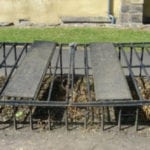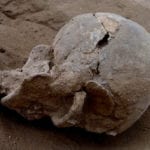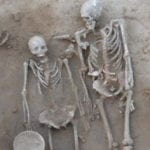 Weird Stuff
Weird Stuff  Weird Stuff
Weird Stuff  Animals
Animals 10 Inspiring Tales of Horses Being Human
 Mysteries
Mysteries Top 10 Haunting Facts About the Ghost Ship MV Alta
 History
History 10 Surprising Stories About the Texas Rangers
 Humans
Humans 10 Philosophers Who Were Driven Mad by Their Own Theories
 Miscellaneous
Miscellaneous 10 Video-Game-Worthy Weapons and Armors from History
 Weird Stuff
Weird Stuff 10 Psychics Who Accurately Predicted Wartime Events
 The Arts
The Arts 10 Pieces of Art Inspired by a Broken Heart
 Health
Health 10 Science Fiction-Sounding New Medical Treatments
 History
History 10 Surprising Facts About the Father of Submarine Warfare
 Weird Stuff
Weird Stuff 10 Times Real Laws Were Based on Bizarre Hypotheticals
 Animals
Animals 10 Inspiring Tales of Horses Being Human
 Mysteries
Mysteries Top 10 Haunting Facts About the Ghost Ship MV Alta
Who's Behind Listverse?

Jamie Frater
Head Editor
Jamie founded Listverse due to an insatiable desire to share fascinating, obscure, and bizarre facts. He has been a guest speaker on numerous national radio and television stations and is a five time published author.
More About Us History
History 10 Surprising Stories About the Texas Rangers
 Humans
Humans 10 Philosophers Who Were Driven Mad by Their Own Theories
 Miscellaneous
Miscellaneous 10 Video-Game-Worthy Weapons and Armors from History
 Weird Stuff
Weird Stuff 10 Psychics Who Accurately Predicted Wartime Events
 The Arts
The Arts 10 Pieces of Art Inspired by a Broken Heart
 Health
Health 10 Science Fiction-Sounding New Medical Treatments
 History
History 10 Surprising Facts About the Father of Submarine Warfare
10 Mass Graves Filled With Animals
A mass grave is sometimes all that remains of a desperate tragedy or cruelty. Animals also end up in boneyards, crushed together in their last moments. From the prehistoric to the recent, some death pits bring new information to the surface while others raise even more questions. Some are even missing. But they all have one thing in common: an aura of sadness that cannot be diluted by time.
10The Aztec Dogs

A rare display of skeletons was unearthed by archaeologists while excavating in the Aztec capital of Tenochtitlan. It was a mass grave containing the well-preserved remains of 12 dogs. While ancient graves everywhere in the world have turned up dogs, they have always been connected with a human burial and never just a group of canines. The Aztec dogs were a unique find, the first of its kind. The purpose of this pet cemetery remains a complete mystery, as it is doubtful that this was an act of love. Aztecs bred dogs chiefly to have the animals end up on their dinner plates and not as pets.
The purpose of the grave is further mystified by the fact that there is no known pattern to the burial. No distinctive Aztec burial habits could be found, and the only thing the dogs had in common was that they were all medium-sized. Beyond that, the dogs’ ages differed, and they were most likely mongrels of varying ancestry. Nearby pottery pieces helped place the date of the burial between A.D. 1350–1520. During that time, the area was near the shore of a now-dry lake where archaeologists have found what they believe to be ancient Aztec trash. It remains unclear whether the dozen dogs had been thrown away after death or buried for some other purpose.
9Jurassic Turtles
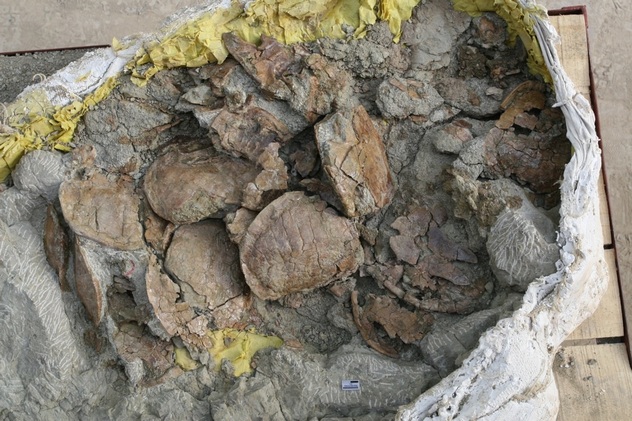
An enormous die-off occurred during the Jurassic era in what is now the northwest province of Xinjiang, China. During a really bad drought, a group of desperate turtles sought the safety of the last remaining local waterhole to await the rain. But when the rain didn’t come, the waterhole dried up, and the turtles perished in agony. All 1,800 of them. Ironically, when the rainfall did come, it was as extreme as the drought, and a violent deluge flooded the bodies into one area where they were to rest for the next 160 million years.
Upon discovery, paleontologists were shocked at the concentration of the corpses. In some places, the fossils were packed up to 36 turtles on top of each other. Despite the tragedy of the mass death, it has given scientists a valuable chance to study these ancient turtles, identified as belonging to the genus Annemys, as the sheer number of the animals allows for a more thorough study of this prehistoric species.
8White Lions & Tigers

One never truly expects to find modern endangered animals in a mass grave, but China—with its disheartening animal abuse record—is the one place where one can find exactly that. Almost 50 carcasses were discovered in a pit 3 meters (10 ft) deep near a zoo in northeastern China after parts of the animals could be seen sticking through the snow. The remains of 14 big cats were found, including endangered white tigers, white lions, and leopards. The zoo’s near-entire population of an endangered bird called the “great bustard” was also part of the grisly discovery, as well as two of the establishment’s three Asian elephants.
All had suffered malnutrition and eventually died of starvation. The zoo claimed the animals’ diets had been “toned down” to save money, and it was a decision that saw predators being given sweet buns instead of meat. Even the zoo’s most treasured possession, the incredibly rare golden monkeys, were fed fruit of useless variety and quality. A month before the grave was discovered, another zoo was closed down after 13 endangered Siberian tigers had starved to death. China’s zoos number more than 200, but only a few large zoos in Beijing and Shanghai are state sponsored.
7A Pterosaur Colony
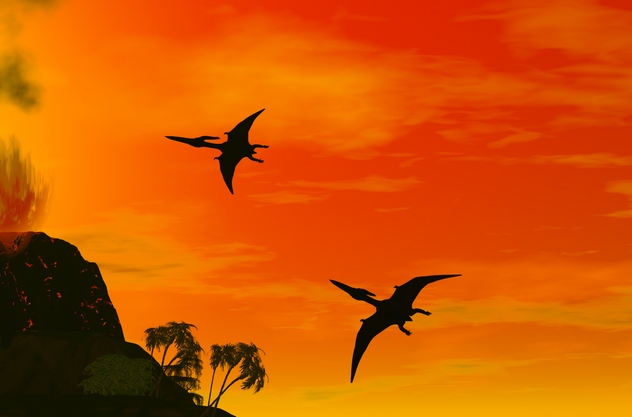
Scientists dream of stuff like this. To find a single skeleton of a new creature is exciting, but it doesn’t reveal much about the species since there is no other to compare it with, especially if the specimen is incomplete. In Brazil, however, scientists not only discovered a new kind of pterosaur but a whole dead colony of them. Sometimes mistaken for dinosaurs, these winged reptiles resembled a bat with an oversized bird’s head.
The Brazilian graveyard covered 65 meters (215 ft) and yielded the overcrowded bones of about 50 individuals of various ages. The newly discovered species, Caiuajara dobruskii, graced the skies about 80 million years ago, gliding on wingspans of up to 2.4 meters (8 ft). It possessed a butterfly-like bony crest on its head that grew as the pterosaur matured. Since the bones were discovered in a single bone bed, it gives weight to the theory that pterosaurs were highly social creatures that lived in groups. What killed off this particular colony remains an unanswered question.
6Olympic Slaughter

When Robert Fawcell decided to claim compensation for suffering from work-related stress, he opened up a grave of trouble. Literally. According to the claim documents, Fawcell was traumatized after his boss had ordered him to cull their sled dog population after their company folded. The firm, Howling Dog Tours, offered rides during the 2010 Winter Olympics. Depending on whom you listen to, Fawcell shot and stabbed between 56–100 healthy huskies to death in gruesome scenes in front of the other doomed dogs who tried to escape and attack him in order to survive.
The BC SPCA received healthy financial backup from the British Columbia government while North American forensics teams helped to remove the carcasses. It was to be one of the most complex and expensive operations the BC SPCA has ever attempted. Despite the expert help, a guilty confession from Fawcell, autopsy documentation proving that at least nine of the dogs had suffered before dying, and Fawcell being convicted for their deaths, the sentencing was not what the BC SPCA had hoped for. Fawcell was given no jail time nor did he receive a lifetime ban from owning or working with animals.
Judge Steven Merrick called the husky slaughter a “horrific criminal offence” but stressed that the killing itself wasn’t illegal, only the way it had been done. Fawcell got off with a $1,500 fine, three years of probation, and a three-year ban on working commercially with animals. He also faced 200 hours of community service and wasn’t allowed to own or work with firearms for 10 years. Fawcell even received his trauma compensation claim that had started the entire thing, but the BC SPCA wants him to return the money.
5World’s Largest Dinosaur Graveyard

In 1997, a mega boneyard was discovered in Alberta, Canada. Covering an area of about 568 acres, thousands of bones turned up in the 76-million-year-old fossil beds. They belonged to a horned and frilled dinosaur called Centrosaurus, a cousin to the more well-known Triceratops. A huge herd of these rhino-sized grazers, numbering in their hundreds, was occupying what was then a coastal area. The vegetation was plentiful and the weather warm, perfect for herbivores. Moving in such large numbers, they must have been awe-inspiring to witness.
When their skeletons were found, it was determined by the way the Centrosaurus herd huddled together that they had failed to escape some deadly cataclysm and had all died at the same time. Whatever happened that day, evidence suggests that a hurricane-force storm was most likely behind the world’s largest dinosaur graveyard. The land was flat and offered no high shelter when a storm flood hit the herbivores. The awkwardly built dinosaurs couldn’t paddle for long in the rising waters, and there was no chance of swimming toward a dry spot as the waters reached miles inland. Inevitably, the great herd drowned.
4Festival Felines

Everybody knows about the ancient Egyptians’ reverence for their feline companions, but it took a truly huge grave to drive the point home. In 1888, an Egyptian farmer accidentally shoveled into a pit that was to reveal the first of many cat mummies. Wrapped in linen, some were in good condition and even bore their original golden masks.
As honored as the kitties had been in ancient times, they were treated with nothing but greed and disrespect after their discovery near the village of Istabl Antar. The best ones were sold to tourists as souvenirs while the rest were pawned off as fertilizer. The exact number of cats found by the farmer remains unclear, but they were in their hundreds of thousands. One ship bound for England carried a cargo of about 180,000 of the grave’s cats alone. The animals are thought to have been offerings during certain annual festivals.
3Marineland’s Mass Graves
Performances at Marineland Canada are allegedly turning into a horror show. The Niagara Falls facility for captive marine mammals was brought to the public’s attention when it was leaked that Marineland had four illegal mass graves on its property. Just one of the graves is packed with 1,000 of their dead animals. Since death is not exactly a business booster, most of the lives snuffed at the park are either not announced or the records not made available.
What activists have pieced together is a grim tip of a very large iceberg. Since 1973, there have been 17 orca deaths and at least 22 dolphin fatalities. On top of that, Marineland currently holds the North American record for the number of beluga deaths. It is estimated that over the years the park has held thousands of both land and sea creatures that had died too soon. SeaWorld even took back their male orca Ikaika, who was there on a breeding loan, out of fear for his health. Ontario’s Ministry of the Environment ordered the park to immediately stop the on-site burials.
2The War Trench
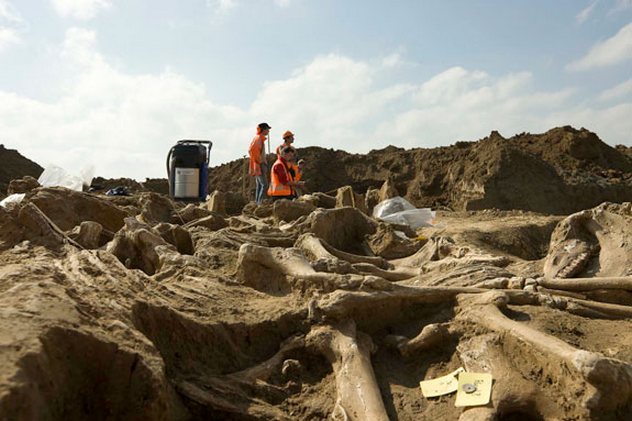
Another history-making grave was located in the Netherlands. This time, it was the largest communal grave of horses in Western Europe. Lacking any saddles and bridles, between 35–50 horses had been hastily thrown into a deep trench about 36 meters (120 ft) long. Archaeologists believe the beasts of burden were probably warhorses that had been massacred in the heat of battle, either during the Eighty Years’ War (1568–1648) or the French siege of Maastricht in 1673.
The French theory proved feasible, since the bodies of French soldiers had been found near the horses’ grave a few years earlier. The death trench, found near Borgharen, Maastricht, was dated to be from the 16th or 17th century, after scientists measured the radioactive decay of carbon in the mortal remains. Since so many dead and rotting carcasses were a health risk, it’s also possible that a defense trench had been picked out of haste and necessity instead of wasting time to dig a new grave.
1The Missing Mass Grave
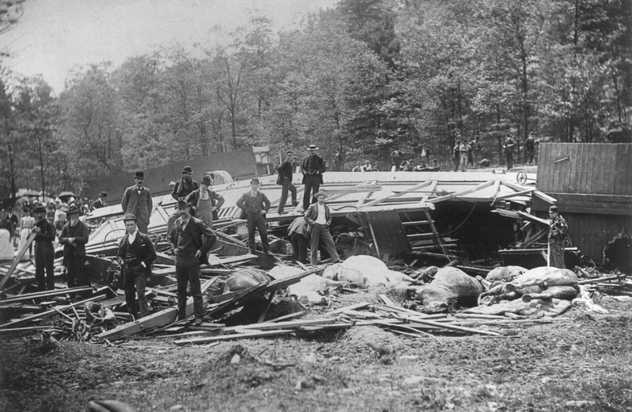
On May 30, 1893, a horrific train smashup occurred near the town of Tyrone, Pennsylvania. The Walter L. Main circus train had a brake failure coming downhill. The final undoing of the circus company proved to be a turn in the tracks, which the runaway train hit with such force that all except the last couple of its 17 cars shot off the tracks. Big cats, elephants, horses, reptiles, a gorilla, and human performers plummeted down a deadly 9-meter (30 ft) drop—some to their deaths. When everything became quiet, it was a pileup of mangled steel and corpses almost back to the level of the tracks it had fallen from. The elephants were injured but alive and were used to help clear up the debris.
From there on, the story gets hazy. It’s known that five people had died, but researchers aren’t so sure what other animals might’ve succumbed apart from the 50 horses and two circus cows said to have been killed. While the performing folk were stranded in Tyrone, they buried the animals in a mass grave on the land of a farmer named Hiram Friday. But now nobody can find it, not even archaeologists with ground-penetrating radar. For years after the accident, sightings of exotic creatures continued in the area, and an actual tiger was shot when it tried to satiate its hunger on a local cow. Nearby townsfolk reported kangaroos and parrots crossing their paths.
The grave itself, however, remains missing.
I’m a freelance writer and editor. I also write romance adventure and kids books, they can be found here and here.

